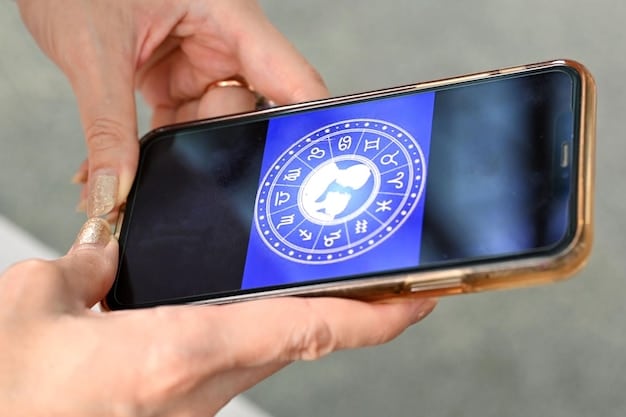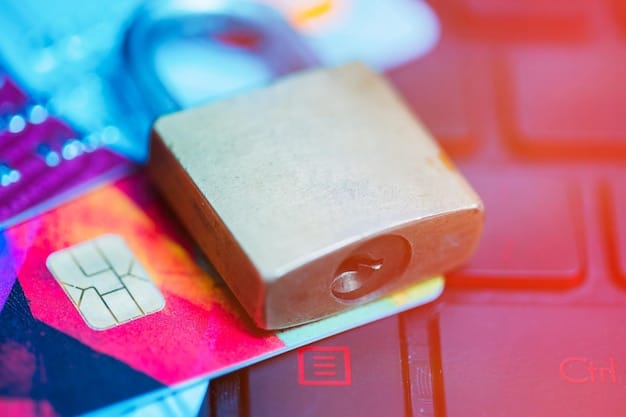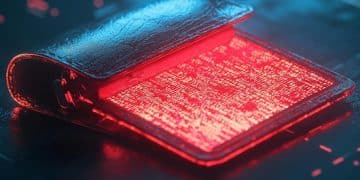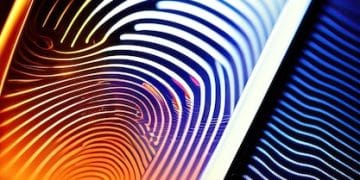Protect Your Crypto: MFA Setup Guide for 2025

Protecting your crypto assets in 2025 requires a robust security strategy, with multi-factor authentication (MFA) being a critical layer of defense against unauthorized access and potential theft. This guide provides a detailed, step-by-step approach to setting up MFA to safeguard your digital investments.
In the ever-evolving landscape of digital finance, ensuring the safety of your cryptocurrency holdings is paramount. One of the most effective ways to bolster your security is by implementing multi-factor authentication (MFA). This Protect Your Crypto: A Step-by-Step Guide to Setting Up Multi-Factor Authentication in 2025 provides a practical roadmap to fortify your digital defenses.
Understanding the Growing Need for Crypto Security
As cryptocurrency adoption continues to rise in 2025, so does the attention it attracts from cybercriminals. Increased value and mainstream acceptance make crypto a prime target for sophisticated attacks, underscoring the essential need for proactive security measures. Understanding these threats is the first step in defense.
The Rising Threat Landscape
The frequency and sophistication of cyberattacks targeting cryptocurrency have steadily increased. From phishing scams to sophisticated malware, attackers are constantly developing new methods to compromise wallets and exchanges.
Why Traditional Passwords Aren’t Enough
While strong passwords are a basic requirement, they are often insufficient for protecting against modern cyber threats. Password reuse, phishing, and data breaches can easily compromise even the most complex passwords. This highlights the need for an additional layer of security.
- Phishing Attacks: Attackers impersonate legitimate services to trick users into divulging their credentials.
- Password Reuse: Using the same password across multiple accounts increases the risk of compromise.
- Data Breaches: Leaked databases of usernames and passwords can be used to access crypto accounts.
- Keyloggers and Malware: Malicious software can intercept passwords and private keys directly from a user’s device.
In conclusion, with the increase in sophisticated cyberattacks, implementing security measure is no longer optional in keeping your assets safe.
What is Multi-Factor Authentication (MFA)?
Multi-factor authentication (MFA) is a security system that requires more than one method of authentication to verify a user’s identity. By combining multiple factors, MFA significantly reduces the risk of unauthorized access, even if one factor is compromised.
The Three Factors of Authentication
MFA typically relies on three distinct categories of authentication factors, providing a layered security approach. These factors ensure that even if one layer is breached, others remain to protect your account.
How MFA Enhances Crypto Security
MFA adds a crucial layer of security by requiring a second form of verification in addition to a password. This makes it significantly harder for attackers to gain access to your crypto accounts, even if they have your password.
- Something You Know: This is typically your password.
- Something You Have: This could be a physical security key, a smartphone, or a trusted device.
- Something You Are: This involves biometric authentication, such as a fingerprint or facial recognition.
In summary, MFA enhances crypto security by adding layers of authentication, creating an extra barrier to keep digital assets safe.
Step-by-Step Guide to Setting Up MFA on Crypto Exchanges
Enabling MFA on your cryptocurrency exchange accounts is a critical step in protecting your digital assets. Most exchanges offer MFA options, such as authenticator apps, SMS verification, or hardware security keys. Here’s how to set it up.

Choosing the Right MFA Method
Different MFA methods offer varying levels of security. While SMS verification is convenient, it is more vulnerable to SIM swap attacks. Authenticator apps and hardware security keys provide stronger protection.
Detailed Instructions for Popular Exchanges
The process of setting up MFA varies slightly depending on the exchange. Here are detailed instructions for some of the most popular platforms:
- Binance: Navigate to your account settings, select “Security,” and then click on “Enable” next to “Google Authentication.” Follow the on-screen instructions to scan the QR code with your authenticator app and enter the verification codes.
- Coinbase: Go to your profile settings, choose “Security,” and click on “2-Step Verification.” Select your preferred method (Authenticator app or SMS) and follow the setup instructions.
- Kraken: In your account settings, find the “Security” section and click on “Two-Factor Authentication.” Choose your preferred method and follow the prompts to complete the setup.
To conclude, enabling MFA on your exchange accounts is a critical step in securing your crypto assets. Choose the method that best fits your security needs and follow the exchange’s instructions carefully.
Securing Your Crypto Wallets with MFA
In addition to exchanges, it’s also essential to secure your crypto wallets with MFA. Hardware wallets often support MFA, providing an extra layer of protection for your private keys. Setting up MFA on your wallet follows a similar process to setting it up on an exchange.
Hardware Wallet MFA Options
Hardware wallets like Ledger and Trezor offer MFA options through PIN codes and passphrase protection. Activating these features ensures that even if someone gains physical access to your device, they cannot access your funds without the correct credentials.
Software Wallet MFA Considerations
Some software wallets also offer MFA options, such as biometric authentication or integration with authenticator apps. Explore the security settings of your software wallet to determine the best way to implement MFA.
- Ledger: Set up a strong PIN code and enable passphrase protection for added security.
- Trezor: Similar to Ledger, use a strong PIN and enable passphrase protection.
- Software Wallets: Check for options like biometric authentication or integration with authenticator apps.
In short, securing your wallets with MFA adds an extra layer to protect your private keys.

Best Practices for Maintaining MFA Security
Setting up MFA is just the first step. Maintaining its security requires ongoing vigilance and adherence to best practices. Regular reviews of your security settings and awareness of potential threats are essential for long-term protection.
Regular Security Audits
Periodically review your MFA settings on all your crypto accounts. Ensure that your recovery methods are up to date and that you are using the strongest available authentication methods.
Staying Alert to Phishing Attempts
Be cautious of phishing emails and messages that attempt to trick you into revealing your MFA codes. Always verify the legitimacy of any request before providing your authentication credentials.
- Use Unique Passwords: Avoid reusing passwords across multiple accounts.
- Enable Biometric Authentication: Use fingerprint or facial recognition where available.
- Store Backup Codes Securely: Keep your recovery codes in a safe place, separate from your primary devices.
- Stay Informed: Keep up-to-date with the latest security threats and best practices.
To summarize, maintaining MFA security involves regular security audits, updating recovery methods, and staying informed about threats.
The Future of Crypto Security: MFA and Beyond
As technology advances, the methods for securing cryptocurrency will continue to evolve. While MFA is a vital tool, it’s essential to stay informed about emerging security solutions and adapt your strategies accordingly. The future of crypto security will likely involve more sophisticated authentication methods and proactive threat detection.
Emerging Authentication Technologies
Biometric authentication, behavioral analysis, and decentralized identity solutions are poised to play a significant role in the future of crypto security. These technologies offer enhanced security and convenience compared to traditional methods.
The Role of AI in Crypto Security
Artificial intelligence (AI) can be used to detect and prevent fraudulent activity in real time. AI-powered security systems can analyze transaction patterns and user behavior to identify and block suspicious activity.
All things considered, the future of crypto security involves emerging authentication technologies, AI-powered security systems, and community-driven security initiatives.
| Key Point | Brief Description |
|---|---|
| 🔑 MFA Importance | Adds an extra layer of security to protect your crypto assets. |
| 📱 Authenticator Apps | Use apps like Google Authenticator for stronger protection. |
| 🛡️ Hardware Wallets | Secure your private keys with hardware wallets supporting MFA. |
| 🚨 Stay Vigilant | Regularly audit your security settings and watch out for phishing. |
FAQ
▼
MFA adds an extra layer of security by requiring multiple forms of verification, making it significantly harder for unauthorized users to access your accounts, even if they have your password.
▼
Common MFA methods include authenticator apps (like Google Authenticator), SMS verification, and hardware security keys. Each offers varying levels of security and convenience.
▼
Navigate to your account settings, select the ‘Security’ section, and choose the MFA option. Follow the on-screen instructions to link your chosen method, such as scanning a QR code with an authenticator app.
▼
Most services provide backup codes or recovery options. Use these to regain access. If you don’t have backup codes, contact the platform’s support team immediately for assistance.
▼
While convenient, SMS verification is less secure than authenticator apps or hardware keys. SIM swap attacks can compromise SMS-based MFA, so consider stronger methods for high-value accounts.
Conclusion
In conclusion, safeguarding your cryptocurrency in 2025 requires a proactive approach, and multi-factor authentication is a cornerstone of that strategy. By implementing MFA on your exchanges and wallets, and adhering to best practices, you can significantly reduce your risk of becoming a victim of cybercrime and ensure the long-term security of your digital assets.





